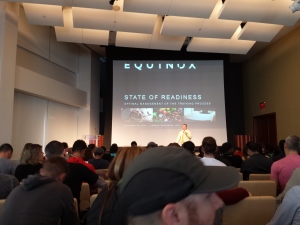If you’re looking for Part 1 of the review, it’s here.
Day 2:
When a conference says that the second day starts at 8 AM you don’t expect that to mean an hour of breakfast and 30 minutes of pre-recorded chatter from an equipment manufacturer. You don’t expect it because that’s a pretty shady way of making it sound like there’s more education than there really is.
Session #1
Brandon Marcello: Breathing Essentials for Performance and Wellbeing.
We missed Brandon speak at a conference earlier this year. It turns out that he’s entertaining and has an easy to follow pedagogical style.
Breathing has been getting a lot of airtime over the last few years. It can be pretty miraculous when it’s the correct intervention. It has also suffered from the effects of polarization, with some saying that it will fix everything and some saying that it won’t fix anything. The truth is, of course, somewhere in the middle. Brandon did a great job of presenting a very fair stance on breathing, hopefully avoiding some of the polarization.
While there was nothing ground-breaking here, it was a fantastic review of the basics of breathing anatomy, the impact breathing has on the nervous system, and what’s in the current research. I’m not sure I agreed with everything stated, but there was plenty of good stuff and plenty of food for thought.
Take away points:
- Breathing can be voluntary or involuntary.
- It is the only (mmm… I’m not 100% convinced here) function through which you can influence the involuntary nervous system.
- Many common disorders that involve an imbalance in the autonomic nervous system may be impacted by breathing.
- The diaphragm is asymmetrical and interdigitates with quadratus lumborum and psoas — the implications for movement and function are profound. (I will definitely be digging deeper into PRI in the future.)
Session #2
Michol Dalcourt: Practical Application of Fascial Fitness
This was a hands-on session. We didn’t catch Michol’s lecture. My general feeling is that a hands-on without a lecture is a waste of time, but nothing else good was going on, so we went for it. Space and time were limited, so we ran through a few movements as a group, using the ViPR as a primary apparatus.
Take away points:
- Multi-planar movement is important.
- One of the trainers thought her external obliques were her psoas.
- Everyone thinks their clients have tight hip flexors — I’m not saying it’s not true, but it was a large group. I have to wonder if they’re testing or guessing.
Session #3
Dr. Charlie Weingroff: State of Readiness. As always, Charlie was entertaining and fired up. He was the first presenter who didn’t seem to mind if not everyone could keep up. He successfully got a lot of information into his limited timeslot.
Charlie drew up definitions that will be more and more important as readiness measures become more popular. With Quantified Body/Quantified Life growing in popularity and accessibility, what may seem like semantics will differentiate those who are capable of taking advantage of new data from those using catch-phrases.
Take away points:
- Readiness measures will help us determine if the trainee is capable of adapting to the training stress that has been planned.
- Readiness is who we are today — i.e., who showed up to the session.
- No matter what you do, there is a cost to doing business.
- The #5 predictor of injury is “training like a douche”. That’s a quote.
- Going lactic too often affects motor control.
- Technology isn’t going to tell you what to do. The coach has a very specific place in the continuum.
Lunch
Way more protein is available today. Way to respond to audience demand!
Session #4
Brandon Marcello: Practical Application of Breathing Essentials. This was a hands-on session. We went through a few breathing drills. Nothing ground-breaking here either, but I appreciate that Brandon went into general breathing principles rather than being married to a PRI, DNS, yoga, etc. methodology.
Take away point:
- If you include breathing at the right times, you don’t need to harp on the importance of breathing. Let the client experience it.
Session #5
Charlie Weingroff & Brandon Marcello: Practical Applications and Testing for Readiness. Does there seem to be something weird about that title? Apparently this was slapped together at the last minute. I don’t know if a presenter dropped out or what, but it was a good chance to get in a Q&A with a couple of the better presenters. There was no specific format, so it was just audience questions.
Interestingly, as Charlie went through some aspects of HRV monitoring in relationship to the Omegawave software, but the Q&A devolved into the personal trainer’s scope of practice and audience members looking for specifics on how the us HRV as a standalone measure for programming.
Take away points:
- Charlie prefers to modify volume rather than intensity in the presence of mid-level HRV scores.
- Don’t tell Charlie that you’re trying to provide a fitness solution to a medical problem. He will embarrass you in front of your co-workers and employers.
The Equinox High Performance Living Symposium was decent overall. Again, it’s only their 2nd year at it. For the cost there are definitely more valuable 2-3 day courses available, but if you don’t need to cover the cost of travel, food, and lodging, it can be worthwhile. I did get the sense that presenters, many of whom I’ve seen before, simplified some things for this audience, but I may be reading into it. Hopefully these will improve each year and hopefully Equinox will remain in the continuing education arena.



